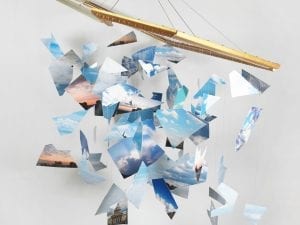Swiss artist Fabien Bruttin’s work is based on an experimental approach with different mediums, technical and pictorial processes. His paintings aim to express a vivid interior world. We catch up with the artist to discuss the fascination behind his accidental creations and the meaning of colour in its organic forms.
A: How do you think your works create textures, and what is the importance of doing this?
FB: As much as I appreciate large format artwork with big swathes of colours, I am always fascinated by pieces where impasto and/or graffito techniques are used. When I discover a painting, I cannot help but observe it from the side. Discovering a profile always gives me great pleasure. In this time of digital technology, why use paint, unless for its thickness? That’s why I like to include in my work a wide pallet of textures. By successive additions of layers of paint, I create the initial profile. Then I scratch the surface. The bottom layers reappear creating interesting textures. I also enjoy it when the paint reacts by itself to the drying and cracks appear. Sometimes I also use sprays to create special textures in some areas that seem a little flat.
A: Could you discuss the processes behind your works; why do you use different types of paint and what is the effect that it creates?
FB: As a child I was always fascinated by toy chemistry sets, where you experiment with various mixtures, creating a reaction which is beautiful for the eyes. Later, I directed my studies towards molecular biology because I liked this experimentation. Naturally, I wanted to transfer this approach when I felt the urge to create. Nowadays, I am equipped with an arsenal of different types of paint such as acrylic, industrial synthetic paint, bitumen etc. that I include in my work. Traditionally, they are not supposed to be mixed, but after all why not? To create with multiple media, you must love to play, do not be afraid to experiment, even if it means spoiling some equipment, and not be discouraged. Of course, it needs some discipline to keep in mind how the materials react. While the process may seem random, it is not. Indeed, with practice, it can be mastered. Although occasionally, I am still pleasantly surprised by accidents!
A: How does colour theory influence your pieces?
FB:This is a point where you cannot rely on chance. With practice and a good eye, the colour selection is made automatically and instinctively. Visually, I like it when in terms of colours, a work seems to “explode” in the face of the viewer, despite its apparent tranquility. Therefore, I play with explosive colour contrast in order to create an effect contradictory to the calm of some of my compositions, which may be viewed as landscapes or seascapes.
A: What are your sources of inspiration?
FB:I am fortunate to live in Geneva, Switzerland, a region where there is a lake surrounded by mountains. it is in this idyllic scenery that I find my main inspiration. In the art world, I am influenced by the Sino-French abstract artist Zao Wou-Ki because his paintings are loaded with poetry. I also appreciate Mark Rothko for the simplicity of his compositions and the mystical aura of his works. Finally, I am also inspired by the artworks of Joseph M. W. Turner, because most of his work is on the edge between figurative and abstract worlds.
A: Do you think it is important for artists to maintain a sense of freedom with their works – letting go of complete control? If so, how does the painting become an artwork in its own right, separate from the artist who creates it?
FB:I believe that every artist is free. Thus, everyone can go their own way. It seems impossible to me that an artwork can be absolutely independent from its creator. Even if the choices of the artist seem completely nonsensical and guided by what appears to be pure chance, they fall into the category of unconscious choices. This act of creation dependent on the artists themselves.
Ironically, this is where all the magic happens and the artwork comes to life for example the aura of Rothko’s works. Without really understanding why, a link is built from work to the viewer, awakening something inexplicable, even if, ultimately, it is the viewer who makes the picture …
A: How does the technique of layering different media – that are not supposed to mix – evoke something new for you, and how did this style develop?
FB:Coming from the world of science, I always liked to experiment with different products. My style has evolved over time. My gestures are now more controlled and my compositions quieter in appearance. However, I continue to use very vivid colours. Sometimes I add figurative elements such as the silhouettes of boats in my work, depending on my mood and the inspiration of the moment.
A: Why is it your intention to create an abstract inner world?
FB:It is very difficult to answer this question, as the words seem far away from what I can express with colours. I do not think it is a conscious intention to create an internal abstract world. I only express what I have inside me and what needs to get out. Afterwards comes the part where the viewers judge whether this world resonates with them. This is where the dialogue begins.
Credits:
1. Fabien Bruttin, Sunset Bay (2016). Courtesy of the artist.




